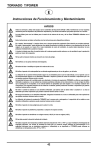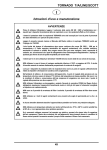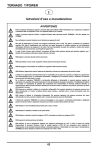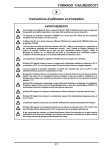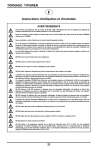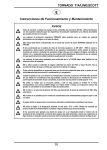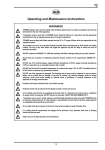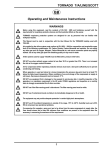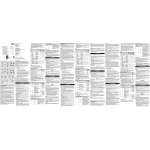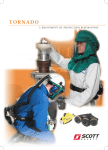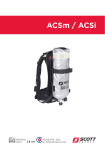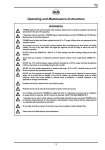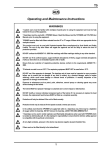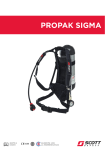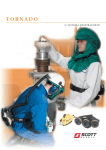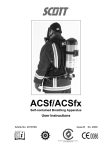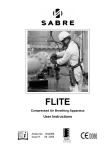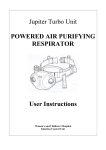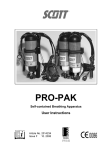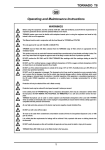Download TPower User Manual in Australian
Transcript
T/POWER Operating and Maintenance Instructions WARNINGS Read this Manual together with the User Instructions for the T head-top and T filters used with T/POWER. Ensure that your selection of respiratory protective devices conform to the requirements AS/NZS1715 : 2009. These instructions must not be confused with instructions for similar devices. In the ‘power off’ state, little or no respiratory protection is to be expected. This is regarded as an abnormal condition. In the ‘power off’ state, a rapid build-up of carbon dioxide and a depletion of oxygen within the hood or helmet may occur. In the unlikely event of a blower failure, the wearer should leave the hazardous area immediately and then remove the equipment. At very high work-rates the pressure inside the face-piece may become negative with the result that the protection may be Iess than expected. DO NOT remove the face-piece while in the hazardous area. DO NOT interfere with the seals in any way whilst work is progressing. DO NOT snag the hose or disturb the fit of the face-piece. DO NOT use the device if the seal is adversely affected by spectacles or beards. The use of an intrinsically safe device in an atmosphere for which it is not listed or the use of a non-intrinsically safe device in a flammable or explosive atmosphere may lead to fire or explosion resulting in serious injury or death. If a T/POWER is used in an explosive or flammable atmosphere, failure to regularly inspect the respirator as described in this instruction, failure to correct damage to the respirator, or the installation of incorrect batteries or substitution of any other components may impair the intrinsic safety of the unit. Impairing the intrinsic safety of the unit may lead to a fire or an explosion which could result in serious injury or death. DO NOT remove or change batteries in a flammable atmosphere. Batteries must only be removed or changed in an area known to be non-flammable to prevent an explosion that may result in serious injury or death. DO NOT charge batteries in a flammable atmosphere. Charge the batteries only in an area known to be non-flammable to prevent an explosion that may result in serious injury or death. Use of the T/POWER with a broken or damaged case or exposed wiring in a flammable or explosive atmosphere may result in a fire or explosion which may cause serious injury or death. DO NOT use in areas immediately dangerous to life or health. DO NOT use in stills, tanks and other confined spaces. DO NOT use in oxygen deficient (<19.5%) or oxygen enriched atmospheres (>23%). DO NOT exceed the design duration of the battery. DO NOT use if the ambient temperature is outside of the range -10°C to +40°C as this invalidates the intrinsic safety approval. Humidity levels up to 95% RH do not present any operational problems. If intrinsic safety (use in a flammable or explosive atmosphere) is not a consideration, T/POWER may be used between -10°C and +50°C. 1 T/POWER The black T/POWER blower is moulded in an anti-static material. INTRODUCTION T/POWER is a powered respirator system which conforms to Australian Standard AS/NZS1716 : 2003. It comprises a blower and a range of batteries, some of which are approved as intrinsically safe for use in explosive or flammable atmospheres EEx ib IIC T3. T/POWER protects against the inhalation of harmful dusts, mists, fumes, vapours, or gases especially where protection is required for long periods, and is of particular benefit in hot or humid environments. As PPE is exempt from the ATEX Directive 94/9/EC, T/POWER cannot be approved to this directive. Scott Health and Safety Limited have demonstrated compliance with the requirements for use in potentially explosive gas atmospheres by having T/POWER approved to EN 50014 : 1977 and EN 50020 : 1977. For potentially explosive dust atmospheres the blower circuit board is low energy and would not present a hazard if exposed. Users should continue to ensure, however, that if the blower suffers any damage to the casing it should be withdrawn from use and replaced. Fig. 1 The following markings appear on the blower and battery and their meanings are described below: The T/POWER casing is approved for resistance against dust and water ingress to EN 60529 : 1991 Code IP54. EEx ib IIC T3 Marking Meaning EEx Electrical apparatus corresponds to one or more of the types of protection which are the subject of the specific European Standards listed above. ib Category for the type of protection used, protection concept - intrinsic safety: Limit the energy of sparks and surface temperatures. IIC Group of the electrical apparatus: For places with a potentially explosive atmosphere other than Mines susceptible to fire damp. T3 Temperature class: For electrical apparatus for Group II, having a maximum surface temperature of 200o C. Explosion protection mark. In addition, the blower and battery are marked with the month and year of construction. In use, filtered air from the T/POWER blower is delivered via a hose to the face-piece and exits through the face-seal or exhalation valve. The basic blower has single filter port. Two additional filters can be fitted by replacing blanking plugs, at each end of the blower body, with filter adaptors (shown as 1 in Fig. 1). T/POWER is electronically controlled to provide sufficient air to the wearer and to warn when: 2 T/POWER • • The correct facepiece together with the correct filters should be chosen, after considering the intended application, the hazards likely to be present and the preferences of the wearer. Flow-rate is too low: the bleeper sounds intermittently and a yellow LED flashes. This warning continues until the unit is switched off or flow-rate reaches a safe level. For example: low flow due to a blocked filter will cause this alarm. Fitting a new filter will cancel the alarm automatically. Battery charge is low: when approximately 5 minutes power remains the bleeper sounds intermittently and red LED flashes. To switch the unit off, the POWER OFF button must be pressed for 3 seconds. Full details of suitable filters and all T/POWER powered respirator systems can be obtained from Customer Services at Scott Health and Safety Limited. LIMITATIONS TO USE • • The replaceable filters are mounted on the belt mounted blower, to which is also connected a rechargeable battery pack. A single filter must always be mounted on the blower. For multi-filter requirements, blanking panels at each the end of the blower body may be replaced with adaptors that permit the attachment of a further two filters. • This product must only be used by trained persons fully aware of prevailing workplace hazards. Some T/POWER systems are for use in potentially explosive atmospheres but must only be considered as intrinsically safe if both the battery and blower are marked as such. Wind speeds in excess of 2 metres per second may affect the degree of respiratory protection expected from the equipment. FILTER SELECTION T/POWER should be fitted with filters appropriate to the application, selected by a competent person with a full knowledge of respiratory hazards, and their concentrations in the workplace. To ensure adequate protection is afforded, it is essential that the T/POWER is correctly configured and that the filters are used in the combinations listed in the following table: Australian Device Classification Required Minimum Protection Factor (RMPF)* Maximum Gas/Vapour Concentration present in the air No. of Gas Filters No. of Combine d Filters No. of Particulate Filters (PF251/2) No. of Particulate Filters (PF251/SUPER) PAPR-P1 Up to 10 x RMPF 1000 ppm (by volume) 2 3 1 1 PAPR-P2 Up to 50 x RMPF 1000 ppm (by volume) 3 3 1/2/3 1 Up to 50 x RMPF # 1000 ppm (by volume) 3 3 1/2/3 1 Over 100 x RMPF # 1000 ppm (by volume) 3 3 1/2/3 1 PAPR-P3 * According to AS/NZS1715 : 2009 # Dependent upon face-piece Please consult the face-piece Instruction Manual for classification and RMPF of the device. Note: • PAPR-P3 filters are suitable for all types of particulate hazards including dust, mist and fume of all types, radioactive dusts, bacteria and viruses. • Please contact Customer Services at Scott Health and Safety Limited for more detailed information on filter selection, appropriate maximum use concentration levels and relevant local legislation. 3 T/POWER The following filters are available for use with T/POWER: Code Filter Type Colour Code TF200 PAPR-A1 (Gas) Brown TF203 PAPR-K1 (Gas) TF220 PAPR-A1-P3 (Combined) TF223 PAPR-K1-P3 (Combined) Green Brown and White Green and White TF233 PAPR-ABEK1Hg-P3 (Combined) PF251/2 PAPR-P3 (Particulate) White PF251/SUPER PAPR-P3 (Particulate) White Application Organic gases and vapours with a boiling point above 65ºC. Ammonia and organic ammonia derivatives. As TF200 plus solid and liquid particulates. As TF203 plus solid and liquid particulates. White, Red, Green, Yellow, Grey, Brown Organic gases and vapours with a boiling point above 65ºC, inorganic and acid gases, as well as ammonia and organic ammonia derivatives, solid and liquid hazardous particles. Solid and liquid particulates, including: dusts, mist, fumes, fibres, bacteria and virus. As PF251/2. Longer lasting, high capacity particulate filter. Note: Gas and combined filters must be used in multiples and one must be mounted on the blower body. FITTING A FILTER Damaged, worn, or badly fitted filter seals permit contaminant to bypass the filter, endangering wearer life and health. When T/POWER is used with more than one filter, the filters must be changed as a set and not individually. All filters must be of the same type. The markings on these filters in relation to AS/NZS1716 : 2003 must not be confused with markings on a filter relating to any other standard. This product must only be used with Protector-branded filters manufactured by Scott Health and Safety Limited. The use of any other filters will negate the approval and will be likely to reduce the level of protection provided. 3. Ensure that the adaptor retainers are inserted from the rear and that they are visible in the holes at the front of the unit. When inserted correctly the retainers should be held in position by the lugs underneath the belt loops. 4. Remove the filter from its packaging which should be undamaged. If in doubt, do not use. 5. Check that the filter has not exceeded its use-by date and that the filter thread is in good condition. Fig. 2 1. Configure the blower by adding or removing filter adaptors (see Fig. 2). 6. Check that the filter is appropriate to the hazard. If in doubt consult a qualified, responsible person. 2. Check that adaptor seals are in good condition and properly fitted. 7. Check that the filter seal is in good condition and properly located. 4 T/POWER 8. Check that the threads in the filter adaptor, or filter body are in good condition and clear of contaminant. for a full shift (7.5 or 8 hours, dependant upon the battery type, as listed in the Spare Parts table). Slide the battery into the blower, ensuring that both clips are engaged (see Fig. 4). 9. Screw the filter firmly home until the tab on the base of the filter passes over st the protrusion or 1 Mark on the blower body or filter adaptor (shown as 1 in Fig. 3). Continue until the filter is finger tight. DO NOT OVER-TIGHTEN. DO NOT nd allow the tab to pass the 2 Mark (shown as 2 in Fig. 3). Fig. 4 5. Fit the appropriate filter(s) after checking the filter seals are in good condition. Follow the instructions in Fitting a Filter. 6. Check that the hose is appropriate for the type of face-piece in use and for any cracks, cuts, distortion or other damage. A damaged hose or wrong type of hose must be replaced. Fig. 3 BEFORE USE 1. Ensure that all parts of the complete equipment have been properly cleaned and decontaminated in accordance with these instructions (see After Use) and/or local statutory guidelines. 7. Fit the face-piece to the blower by inserting the hose connector into the blower outlet. This is only possible when the arrow on the connector is aligned with the arrow on the blower body (see Fig. 5). Rotate the connector clockwise past the notch. This secures the connector to the blower. 2. Check that the blower body and adaptors (If fitted) are not damaged or likely to leak. 3. Check that the inspection/service record is up-to-date (monthly inspection is the minimum requirement) and that the daily checks have been carried out. The user may find it convenient to personalise the battery and blower by filling in the user identity labels. Using a ballpoint pen, print the appropriate initials on the foil label, remove the protective paper from the transparent cover and press it firmly down. 4. Check that the battery is not damaged, has been freshly charged and is of the required design duration. The medium capacity battery is for a half shift (4 hours) and the high capacity battery is Fig. 5 5 T/POWER 8. Carry out a flow-rate test: a) Switch on T/POWER with the flow-tester correctly fitted. The unit should bleep once. b) Check that the float rises completely above the TM line (see Fig. 1). IN USE Safety: To ensure that the expected level of protection is attained: Check that the filter canister is not damaged. DO NOT use the T/POWER for longer than the design duration. If there is a perceived reduction in air-flow leave the work area immediately and check the equipment and the flow-rate. Note: The flow-test determines the fact that the minimum flow-rate of the blower is being achieved, it does NOT establish the available duration which depends on the battery in use and its state of charge. AFTER USE Where the equipment must be cleaned and decontaminated when leaving the work area, a ‘dirty‘ area, remote from the hazardous environment, should be set aside for this. 9. Refit the hose and inspect the facepiece, checking that the face-piece, faceseal, head harness and hose are secure and undamaged. Tug the hose connection to ensure it is secure. 1. Remove any protective clothing with the T/POWER still running. 10. Check that the belt is secure and undamaged and fasten the blower to the waist. The belt is adjustable and T/POWER can be worn in any comfortable position, although it is recommended that it is kept behind the wearer with the belt moderately tight. 2. Remove any loose contamination from the outside of the unit with a brush or cloth. 3. 11. Switch on T/POWER and check that the unit beeps: once for a closed face-piece, twice for an open face-piece. 5. The unit must be cleaned before being stored, use a damp cloth to remove dust from all surfaces, or a brush for awkward areas. Ensure that the LED indicators are clean and clearly visible. All cleaning/decontamination must be completed by trained, responsible persons. Care must be taken that no harmful dusts can be inhaled or ingested while this work is completed. 12. Fit the face-piece following the appropriate instructions ensuring that the hose is not twisted or looped as this may restrict movement or the air-flow. 13. Remove the face-piece. 4. Switch the T/POWER off, undo the belt and cap the filters. Put the unit to one side and complete any personal hygiene. Proceed to the work area. 6. Make absolutely certain that no contaminant falls into the blower inlet fan housing whilst the filter is being removed. Do not immerse any part of the equipment during the cleaning procedure. In particular, water must not be allowed to enter the fan housing, hose or face-piece, as this will cause contamination which will be difficult to remove. 7. Clean using a clean lint-free cloth moistened in water and allow to dry in a well ventilated area; do not use radiant heat. DO NOT USE A DRY CLOTH as this may cause the body to acquire and store a static electrical charge. 6 T/POWER 8. Recharge the battery. Batteries must only be charged in a clean dry atmosphere away from direct sources of heat within the recommended storage conditions and NEVER in a potentially explosive atmosphere. 6. Visually check the exhalation valve, where fitted, by removing the cover and inspecting the valve for distortion, cuts or cracks. 7. Condition of the visor: scratched visors may obscure vision and are a potential hazard. Before charging the battery, ensure that the charger and mains voltage are compatible. Connect the charger to the battery via the concentric plug and switch on at the mains. The red LED on the charger should illuminate and remain illuminated throughout the charging period. 8. Condition of the battery: batteries with cuts or cracks MUST NOT be used and should be replaced immediately. All rubber parts should be replaced at least annually, regardless of usage. This includes exhale valves, filter seals, sealing O-Rings for the filter adaptors, end plates and the hose connection ORing. The battery should become fully-charged in approximately seven hours. Optimum performance with new battery packs is achieved after they have been cycled three times. Damaged or defective parts must be replaced with genuine Protector spares (see Spare Parts). Use of other spare parts is likely to degrade the performance of the equipment and will invalidate the warranty. All replacements should be noted in the service record. For further details, please refer to the instructions supplied with the charger. STORAGE When not in use the equipment should be stored in a clean, dry environment, away from direct heat sources between -10ºC and +30ºC, at a humidity of less than 65% RH. Note: • The filter seals used in the blower and the filter adaptors are similar in appearance but are not interchangeable. In order to assist identification the filter adaptor seals are moulded in red. • Fit filter seals so that the part number is against the blower body or adaptor. INSPECTION/MAINTENANCE The following components should be checked daily when T/POWER is in regular use: 1. Inspect the face-piece seal(s) for any signs damage, or excessive distortion. An inadequate flow-rate may be caused by any one of the following faults, which should be checked in turn: clogged filter, split hose, battery charge low, equipment fault in the blower, battery or charger. 2. Check the integrity of the head harness, bed fixing and webbing. 3. Condition of the hose, which should have no cuts or cracks. Ensure that the sealing O-Ring on the hose blower connection is present, undamaged and lightly greased. If a faulty battery, fan unit or charger is suspected, the complete unit must be returned to a Protector Respiratory Service Centre, complete with a decontamination certificate and a note detailing the faults. 4. Condition of the blower, particularly the threads, filter sealing face(s) and rubber seals. T/POWER is a sealed, calibrated-for-life unit and contains no serviceable internal parts. 5. Flow-rate, using the appropriate indicator. 7 T/POWER Regardless of usage, each unit requires a documented monthly inspection of all aspects relating to safety. This should be carried out by a trained, responsible person. Records may be entered in the section at the end of this manual, or separately if this is more convenient. Records should be maintained throughout the life of the equipment and should be stored for 5 years thereafter. RECORD INSPECTION AND MAINTENANCE DETAILS Record test and maintenance details on the Inspection and Maintenance Record Sheet provided at the back of this Manual. Information recorded usually includes: • Name of employer responsible for the apparatus. • Make, model number or identification mark of the apparatus, together with a description of any distinguishing features, sufficient to enable clear identification. • Date of the inspection/ maintenance together with the name, signature or unique authentication mark of the examiner. • Condition of the apparatus, details of any defects found and any remedial action taken. 8 T/POWER SPARE PARTS Item No. 1 Description Adaptor Retainer Part No. (Pack of 2) 1022647 2 Filter Adaptor (Pack of 2) TOR/ADAPT 3 Adaptor O-Ring (Pack of 10) 1028131 4 Filter Seal - Red (Pack of 10) 1022652 5 Filter Seal - Black (Pack of 5) 1022190 6 6 6 Battery - 4 Hour Capacity (NiCd) Battery - 7.5 Hour Capacity (NiMH) Battery - 8 Hour Capacity (NiCd) 7 Blanking Plug 8 Waist-belt ECWB 9 Blower Unit Assembly 1070614 - Flow Tester PPFI92/ASSY/TOR - Smart Battery Charger TOR/BC/SM - Holdall BAG/PPR TOR/BATT/M TOR/BATT/LITE TOR/BATT/H (Pack of 2) 9 1074357 T/POWER WARRANTY NOTIFIED BODIES The products manufactured at our factories in Skelmersdale and Vaasa carry a warranty of 12 months (unless stated otherwise) for parts, labour and return to site. The warranty period runs from the date of purchase by the end user. Inspec International Limited (0194) 56 Leslie Hough Way, Salford, Greater Manchester, M6 6AJ, England. BSI Product Services (0086) Kitemark House, Maylands Avenue, Hemel Hempstead, HP2 4SQ, England. These products are warranted to be free from defects in materials and workmanship at the time of delivery. SCOTT will be under no liability for any defect arising from wilful damage, negligence, abnormal working conditions, failure to follow the original manufacturer’s instructions, misuse or unauthorised alteration or repair. SAI Global 286 Sussex Street, Sydney, NSW 2000, Australia. Certificate Number: SMK1214 Evidence of purchase date will need to be provided for any claims arising during the warranty period. All warranty claims must be directed through SCOTT Customer Services and in accordance with our sales return procedure. Intrinsic Safety: Sira Certification Service (0518) South Hill, Chiselhurst, Kent, BR7 5EH, England. Certificate Numbers: Ex 95C2060X Ex 97D2159X 10










